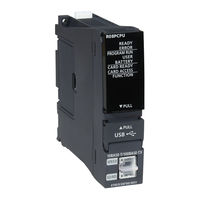Mitsubishi Electric MELSEC iQ-R120PCPU Manuals
Manuals and User Guides for Mitsubishi Electric MELSEC iQ-R120PCPU. We have 3 Mitsubishi Electric MELSEC iQ-R120PCPU manuals available for free PDF download: User Manual
Mitsubishi Electric MELSEC iQ-R120PCPU User Manual (760 pages)
Process CPU Module
Brand: Mitsubishi Electric
|
Category: Controller
|
Size: 22.37 MB
Table of Contents
-
Introduction13
-
Terms27
-
-
Overview38
-
Programming48
-
-
-
-
I/O Refresh84
-
Scan Time86
-
Refresh Mode97
-
Direct Mode100
-
Program Flow102
-
Precautions135
-
-
Data Memory147
-
Refresh Memory147
-
SD Memory Card149
-
Memory Operation152
-
Files153
-
File Size156
-
-
Part 6 Functions181
-
-
Precautions203
-
Error Clear210
-
Precautions219
-
-
Remote RUN/STOP221
-
Executing Method221
-
Precautions222
-
Remote PAUSE223
-
Executing Method223
-
Remote RESET225
-
Executing Method226
-
-
-
Specifications259
-
Data Type260
-
Each Scan261
-
Logging Type266
-
LED Status283
-
Internal Buffer285
-
Missing Data290
-
Auto Logging292
-
-
Backup Function316
-
Precautions322
-
Precautions332
-
-
-
Stop Setting340
-
Clock Data344
-
Execution Timing366
-
Precautions366
-
-
Setting Method369
-
Setting Example370
-
Precautions371
-
-
-
Procedures373
-
Precautions375
-
System Switching376
-
Precautions387
-
Tracking Data391
-
Tracking Mode402
-
Precautions405
-
Auto Memory Copy409
-
Precautions413
-
Files417
-
Operating Status418
-
SD Memory Card419
-
Precautions424
-
-
Device List450
-
Device Setting452
-
User Device454
-
Input (X)454
-
Output (Y)454
-
Latch Relay (L)455
-
Link Relay (B)455
-
Annunciator (F)455
-
Edge Relay (V)458
-
Step Relay (S)458
-
Timer459
-
Counter467
-
System Device471
-
Precautions476
-
Precautions480
-
Nesting (N)485
-
Pointer (P)486
-
Global Pointer486
-
Local Pointer487
-
Pointer Setting488
-
Global Device491
-
Local Device492
-
Advertisement
Mitsubishi Electric MELSEC iQ-R120PCPU User Manual (417 pages)
Ethernet
Brand: Mitsubishi Electric
|
Category: Controller
|
Size: 16.56 MB
Table of Contents
-
Introduction10
-
Terms16
-
-
-
Precautions24
-
-
-
-
Sending Side52
-
-
Precautions69
-
-
-
No Procedure74
-
Pairing Open79
-
Precautions80
-
Data Format81
-
-
Precautions99
-
Data Format99
-
-
-
FTP Command124
-
FTP Command List124
-
Drive Name126
-
FTP Client134
-
Writing Files135
-
Deleting Files135
-
FTP Password135
-
Monitoring Timer136
-
-
-
-
Precautions141
-
-
-
Style Sheet146
-
Refreshing Cycle148
-
Available Files148
-
CGI Object160
-
Device Name160
-
Device Size161
-
Device Read CGI162
-
Display of HTML164
-
HTML Example164
-
Device Write CGI168
-
Error Message173
-
-
-
Remote Password176
-
Set Connection181
-
-
-
Module Type List185
-
Target PLC No.186
-
Latency Time190
-
Precautions193
-
-
Usage Methods216
-
Precautions219
-
-
Basic Settings
243 -
-
Frame Settings252
-
Jumbo Frame252
-
Current Password254
-
-
-
Password Setting254
-
DNS Settings255
-
Time Setting261
-
Security265
-
Subnet Address266
-
-
-
System Parameter329
-
-
Event List
331 -
Appendices
335
Mitsubishi Electric MELSEC iQ-R120PCPU User Manual (110 pages)
Brand: Mitsubishi Electric
|
Category: Controller
|
Size: 15.7 MB
Table of Contents
-
Introduction12
-
Terms16
-
Rj71En71
19 -
CPU Module
25 -
Rj71Gf11-T2
30 -
-
Precautions59
-
Advertisement
Advertisement
Related Products
- Mitsubishi Electric MELSEC iQ-R120ENCPU
- Mitsubishi Electric MELSEC iQ-R120CPU
- Mitsubishi Electric MELSEC iQ-R120PSFCPU
- Mitsubishi Electric MELSEC iQ-R120SFCPU
- Mitsubishi Electric MELSEC iQ-R16MTCPU
- Mitsubishi Electric MELSEC iQ-R16ENCPU
- Mitsubishi Electric MELSEC iQ-R16CPU
- Mitsubishi Electric MELSEC iQ-R16PSFCPU
- Mitsubishi Electric MELSEC iQ-R16PCPU
- Mitsubishi Electric MELSEC iQ-R16SFCPU


